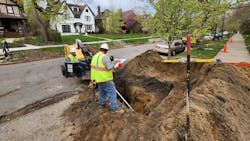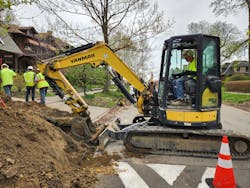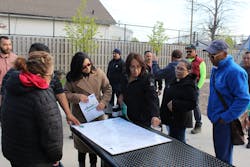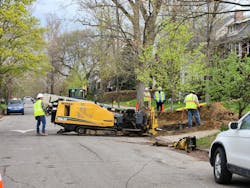How Detroit uses machine learning to solve its lead service line challenges
Detroit's drinking water system is extremely robust, but comes with challenges.
It includes 2,700 miles of water distribution lines. Laid end-to-end, that's enough plumbing to drain Lake Huron into the Pacific Ocean. The average age of any portion of that water system is 95 years old. Some of the 30-inch mains serving the trendiest parts of Midtown were laid in the 1880s, and the bulk of the system was put in place during the city's boom years, from the 1920s through 1960s.
That system was built for a growing population of 1.7 million—the fourth most populous city in the United States at the time.
But the Detroit of the 1960s — the city of Motown, Ford Mustangs and a flourishing middle class — is not the Detroit of the 2020s. Today, the city has 700,000 residents — less than half what the water system was designed to serve. And many of these residents are struggling.
Roughly 35% of Detroit's current residents live below the poverty line and 70% are at less than 200% of the federal poverty line. Detroit has a 50% higher rate of disability than the rest of Michigan, with half as many college graduates, 33% fewer homeowners, and a 10% lower rate of workforce participation.
Situated on the Great Lakes, Detroit has access to the largest source of freshwater on the planet. However, the Detroit Water and Sewerage Department (DWSD) must deliver that water through a century-old water system that still has many lead service lines.
Given the economic realities of the city, "This isn't a situation where we can raise the rates, raise more money, and just keep going," said Sam Smalley, DWSD’s chief operating officer. "Moreover, because of the age of the system, we can't divert all investment for the next 20 years into a singular issue, like lead service line replacement. We have to manage all of it at the same time."
Evolving regulations strain an aging water system
In 2017, potential changes to Michigan's Safe Drinking Water Act were afoot, which would transform it into the most stringent set of water quality standards in the country. The Federal Safe Drinking Water Act has, for years, set the lead action level at 15 parts per billion (ppb). Michigan was looking to set the state’s at 12 ppb.
But DWSD had little confidence in this number, given the age and condition of its records. For example, tap cards from the 19th and early 20th century did not routinely list material types, and crews performing maintenance did not reliably note what material they saw, removed, or left as a replacement.
Scoping the problem without potholing every service line
Throughout late 2017 and early 2018, DWSD took initial measures to improve its records. It put new procedures in place and equipped everyone from field crews to meter changers and inspectors with a mobile app, making it easy to confirm and collect service line materials. DWSD worked with other agencies to bring census and health department data into a geographic information system (GIS).
The department also launched an outreach campaign to educate the public on why this work was important and how it would be accomplished.
In advance of replacing a lead service line, DWSD works with residents to ensure they understand, make their house available for the replacement work, and know about post-replacement steps, including flushing the plumbing after the replacement.
In addition to education resources, DWSD provided self-reporting tools to capture service line material and equipped homes at risk of lead contamination with NSF-certified water filters.
All of these efforts improved the quality of DWSD's initial preliminary service line inventory, which was submitted to the State of Michigan’s Department of Environment, Great Lakes, and Energy (EGLE) in 2019. But its confidence level remained low. While the revised best estimate was that the city had around 80,000 lead service lines, the true number could have been as low as 50,000 or as high as 110,000.
"We have all our data in the GIS layer [map]" Smalley said. "We can visually see where the elevated blood levels are and where the density of known lead services are. But we still don't know what we don't know. There are 311,000 services throughout the city. We probably have 15,000 data points. So there's a whole lot more data yet to be captured."
The cost of such a project would have exceeded DWSD’s entire water supply operating budget.
"We were deeply concerned about having to spend $150 million without having done one thing to improve water quality or mitigate lead," Smalley said. "So we partnered with BlueConduit to use a statistical analysis approach that would satisfy Michigan's Clean Water Act."
Finding potential patterns behind lead service lines
"This issue goes beyond compliance," Smalley said. "Everyone knows that lead, in any amount, is an irreversible neurotoxin. This is about protecting the intellectual capacity of the next generation of Detroiters. Based on [DWSD Director] Gary Brown's vision and setting the standards that we're not going to hide behind simple compliance with the Safe Drinking Water Act, we wanted to get out in front of it and stay out in front of it. And the best way is to get the lead lines out.”
With support from the Rockefeller Foundation and Kresge Foundation, DWSD officially partnered with BlueConduit in 2021, with work beginning in earnest in 2022.
BlueConduit data scientists were able to use the data DWSD had already gathered and use it to train a set of machine-learning models and algorithms. These uncovered correlations and possible patterns in the locations of potential lead service lines in Detroit.
Instead of performing hydrovac inspections on thousands or tens of thousands of service lines, BlueConduit was able to create a representative sample of 384 specific locations. Determining the service line material at those addresses would give BlueConduit the information it needed to take DWSD's preliminary service line inventory from 60% accurate to greater than 90%.
Doing the impossible on a budget
As always, money was the major obstacle in addressing Detroit's lead service lines. EGLE said Detroit had to replace LSLs within 20 years. That alone would cost $30 million per year.
Doing so while continuing normal operations and maintenance would require a 25% increase in DWSD's budget—and demand that some of the most vulnerable people in the state bear this cost.
Given the scope of the problem, the cost of the solution, and the realities of funding, DWSD had previously had every reason to believe it was embarking on a 40-year project that might cost billions of dollars.
Increasingly, DWSD is finding that this new approach — which aligns public agencies, the private sector, and the community in collecting data, then uses advanced machine-learning tools to make the most of what it collected — is persuasive to granting agencies.
"I think that our approach, coupled with our outreach and our collaboration with others, including BlueConduit, help put us over the top,” Smalley said. “Now money is starting to make itself available, through ARPA [the American Rescue Plan Act of 2021] funding, through bipartisan infrastructure money and other grants that are out there. We're collaborating with a lot of other State and Federal agencies to find ways to pay for this. We're increasingly confident we'll meet our goal to be done with this in 10 years."
About the Author
Ian Robinson
Ian Robinson is the president and chief operating officer of BlueConduit, based in Ann Arbor, Mich. He can be reached at [email protected].



